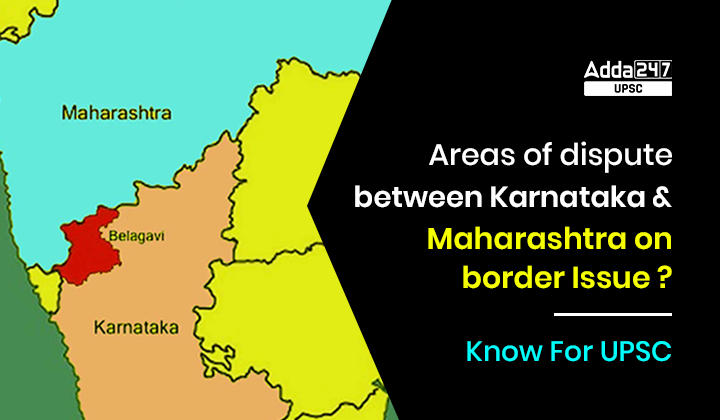Table of Contents
Relevance of Karnataka & Maharashtra Border Dispute for UPSC
Areas of dispute between Karnataka & Maharashtra on border Issue:
- GS 1: Post-independence consolidation and reorganization within the country.
- GS 2: Issues and challenges pertaining to the federal structure
- GS 3: Internal Security
Why ”Karnataka-Maharashtra Border Dispute” in news?
- Today i.e. on November 30 the Supreme Court will hear arguments about the maintainability of a petition filed by the Maharashtra government.
- In this petition, the Maharashtra government challenging some provisions of the State Reorganization Act, 1956 and demanding 865 villages from five districts of Karnataka.
Also Read:
Sri Kanaka Dasa: A great poet and musician from Karnataka
History of the Karnataka-Maharashtra Border Dispute
- The dispute between Karnataka & Maharashtra is going ever since the State Reorganization Act was passed by the Indian Parliament in 1956.
- The Act was based on the findings of the Justice Fazal Ali Commission, which was appointed in 1953 and submitted its report two years later.
- On November 1, 1956, Mysore state – later renamed Karnataka – was formed, and differences between the state and the neighbouring Bombay state – later Maharashtra – erupted.
What was Maharashtra’s stand?
Maharashtra was of the view that the northwestern district of Karnataka, Belagavi, should be part of the state, leading to a decade-long violent agitation and formation of Maharashtra Ekikaran Samithi (MES), which still holds sway in parts of the district and the eponymous city.
Also Read:
Justice Meharchand Mahajan Commission
- Amid protests and pressure from Maharashtra, the Union government set up a commission under retired Supreme Court judge Justice Meharchand Mahajan on October 25, 1966. S Nijalingappa was the Karnataka Chief Minister then and VP Nayak was his Maharashtra counterpart.
- The report was expected to be a binding document for both states and put an end to the dispute.
- The commission submitted its report in August 1967, where it recommended merging 264 towns and villages of Karnataka (including Nippani, Nandgad and Khanapur) with Maharashtra, and 247 villages of Maharashtra (including South Solapur and Akkalkot) with Karnataka.
- Though the report was tabled in 1970 in the Parliament, it was not taken up for discussion.
- Without the implementation of the recommendations, demands of Marathi-speaking regions to be part of Maharashtra and Kannada-speaking regions to be part of Karnataka continued to grow.
Also Read:
Daily Current Affairs: 29th November 2022 | UPSC Prelims Bits
On which legal issues the Apex Court will hear the Case?
- Maharashtra approached the Supreme Court in 2004, challenging the State Reorganization Act. It demanded 865 villages and towns from five Karnataka districts to be merged with the state. The five districts are Belagavi, Karwar, Vijayapura, Kalaburagi and Bidar.
- However, almost two decades after the petition, its maintainability remains challenged.
- Karnataka has resorted to Article 3 of the Indian Constitution to argue that the Supreme Court does not have the jurisdiction to decide the borders of states, and only Parliament has the power to do so.
- Maharashtra has referred to Article 131 of the Constitution, which says that the Supreme Court has jurisdiction in cases related to disputes between the Union government and states.
Also Read:
Important Articles on Internal Security
Important Articles on Polity & Governance
FAQs
Q. Justice Meharchand Mahajan Commission is related to which issue?
Ans. To resolve the Karnataka-Maharashtra Border Dispute, Union government set up a commission under retired Supreme Court judge Justice Meharchand Mahajan on October 25, 1966.
Q. Which is the area of border dispute between Maharashtra and Karnataka?
Ans. Maharashtra government challenging some provisions of the State Reorganization Act, 1956 and demanding 865 villages from five districts of Karnataka.
Q. Which state approached Supreme Court on Maharashtra and Karnataka border spare?
Ans. Maharashtra approached the Supreme Court in 2004, challenging the State Reorganization Act.




 TSPSC Group 1 Question Paper 2024, Downl...
TSPSC Group 1 Question Paper 2024, Downl...
 TSPSC Group 1 Answer key 2024 Out, Downl...
TSPSC Group 1 Answer key 2024 Out, Downl...
 UPSC Prelims 2024 Question Paper, Downlo...
UPSC Prelims 2024 Question Paper, Downlo...




